Relations with Strangers
In the middle of the 19th Century, there were very few roads in the Maritime provinces; those that existed were earthen and gravel roads over which one bumped along in a sleigh or ox-cart. The most practical communication routes were still the navigable waterways. New Brunswick in particular enjoyed an elaborate network of steamboats that plied the waters and tributaries of the St. John River, which traversed the province from north to south. In Nova Scotia, a province composed of a peninsula and Cape Breton Island, steamers could reach the cities and villages by sea. Steamers also came from the Atlantic coast and Europe, bearing millions of dollars in merchandise and hundreds of thousands of immigrants and emigrants. From the 1870s on, the Maritimes were crisscrossed with railways, facilitating the transportation of both resources and people.
Despite these very considerable improvements in transportation, the cities and villages of the Maritimes were remarkably isolated communities. News, newspapers and telegraphs circulated easily, but most people who had been born in the Maritimes remained in their community of origin, unless they emigrated for good. In sum, the populations of communities were relatively stable and above all homogeneous.
For these communities, a stranger was any person who wasn’t from the area, wasn’t related to anyone else in the area, was born in another country or was not of the same ethnic origin as the majority. For an Acadian in Clare, an “Englishman” from Halifax or even Digby was a stranger. When an Irishman disembarked in the port of Halifax or St. John, he was a stranger, the moreso if he was poor, sick or without family. For an Anglo-Protestant in Woodstock, New Brunswick, an Acadian newly arrived from Caraquet was a stranger, the moreso because he belonged to a minority that was considered to be in every respect inferior. In those days, for the Anglo-Protestant majority of the Maritimes, the English language and Protestant religion were the marks of civilization and superiority, while their absence was a clear indication of inferiority, deserving condescendence or even contempt. In short, if you did not have solid ties to the community, family connections or property, you were a stranger.
It goes without saying that when Jerome landed at Sandy Cove, he was the epitome of the stranger: he came out of nowhere, no one knew him or could vouch for him, he didn’t speak the language (he didn’t speak at all) and what’s more he was penniless and handicapped. When the residents of Digby Neck decided that Jerome was Italian, therefore Catholic, it was essential that he be sent “to be with his own kind.” The Acadians of Clare were Catholic, yes, but they were not Italians. So he was sent to the Corsican, Jean Nicolas.
In the 19th Century, “strangers” and recent immigrants to the Maritimes had a difficult time becoming part of the community. Some, like Jean Nicolas, would never really succeed and would leave the area to return to their country of origin, or else try again somewhere else. This would be the case for the majority of new arrivals from Great Britain and Ireland. Indeed, in the 1871 Canadian census, more than two million citizens gave the British Isles as their place of origin. After passing through the ports of Halifax or St. John, they continued on their way towards Ontario, the West or even the United States. Nevertheless, the poorest among the immigrants (such as the Irish who came between 1845 and 1850 to escape the Great Famine) were extremely unwelcome in the Maritime provinces, especially if they were Catholic. In the 1840s and 1850s there were countless incidents, ranging from simple street battles to bloody riots, between Protestant residents and newly-arrived Catholics.
During the second half of the 19th Century in the Maritimes, Christian charity demanded that care be extended to the neediest of the new arrivals, but nothing required that they be trusted and not feared. Strangers were regarded with suspicion. They weren’t members of the community; therefore, the community wasn’t responsible for them.
Further Reading
See, Scott W. Riots in New Brunswick: Orange nativism and social violence in the 1840s. Toronto: University of Toronto Press, 1993.
Carrigan, D. Owen. “The Immigrant Experience In Halifax, 1881-1931.” Canadian Ethnic Studies, 1988 20(3): 28-41.
Oral History or Interview


